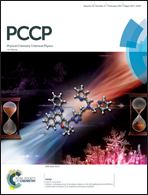Polaron dynamics in anisotropic Holstein–Peierls systems
Abstract
Polaron dynamics in anisotropic organic molecular semiconductors is theoretically investigated and simulated in the framework of a semi-classical Holstein–Peierls model. Our computational protocol is presented and applied to studies of a two-dimensional molecular crystal. The intermolecular (Peierls) parameters for a particular crystal direction are systematically changed in order to study the effect of anisotropy in the system. The usefulness of this methodology is highlighted by studying the polaron dynamics on a picosecond timescale, which provides a microscopic insight into the influence of the interplay between different intramolecular parameters on the charge transport mechanism. Our results show that the polaron mobility is substantially reduced in going from an anisotropic to an isotropic relationship between the Peierls parameters for different directions in the crystal. Interestingly, the molecular charge distribution presents three different signatures corresponding to a one-dimensional polaron, a two-dimensional polaron, and an intermediate state for which the polaron localization depends on the degree of anisotropy. Importantly, the two-dimensional polaron, which is present in the essentially isotropic system, is immobile whereas the other two types of polarons are mobile. This, in order for polaron transport to occur in a two-dimensional molecular based system, this system has to be anisotropic.



 Please wait while we load your content...
Please wait while we load your content...